Theshani Nuradha
Query Complexity of Classical and Quantum Channel Discrimination
Apr 17, 2025Abstract:Quantum channel discrimination has been studied from an information-theoretic perspective, wherein one is interested in the optimal decay rate of error probabilities as a function of the number of unknown channel accesses. In this paper, we study the query complexity of quantum channel discrimination, wherein the goal is to determine the minimum number of channel uses needed to reach a desired error probability. To this end, we show that the query complexity of binary channel discrimination depends logarithmically on the inverse error probability and inversely on the negative logarithm of the (geometric and Holevo) channel fidelity. As a special case of these findings, we precisely characterize the query complexity of discriminating between two classical channels. We also provide lower and upper bounds on the query complexity of binary asymmetric channel discrimination and multiple quantum channel discrimination. For the former, the query complexity depends on the geometric R\'enyi and Petz R\'enyi channel divergences, while for the latter, it depends on the negative logarithm of (geometric and Uhlmann) channel fidelity. For multiple channel discrimination, the upper bound scales as the logarithm of the number of channels.
Quantum Doeblin Coefficients: Interpretations and Applications
Mar 28, 2025



Abstract:In classical information theory, the Doeblin coefficient of a classical channel provides an efficiently computable upper bound on the total-variation contraction coefficient of the channel, leading to what is known as a strong data-processing inequality. Here, we investigate quantum Doeblin coefficients as a generalization of the classical concept. In particular, we define various new quantum Doeblin coefficients, one of which has several desirable properties, including concatenation and multiplicativity, in addition to being efficiently computable. We also develop various interpretations of two of the quantum Doeblin coefficients, including representations as minimal singlet fractions, exclusion values, reverse max-mutual and oveloH informations, reverse robustnesses, and hypothesis testing reverse mutual and oveloH informations. Our interpretations of quantum Doeblin coefficients as either entanglement-assisted or unassisted exclusion values are particularly appealing, indicating that they are proportional to the best possible error probabilities one could achieve in state-exclusion tasks by making use of the channel. We also outline various applications of quantum Doeblin coefficients, ranging from limitations on quantum machine learning algorithms that use parameterized quantum circuits (noise-induced barren plateaus), on error mitigation protocols, on the sample complexity of noisy quantum hypothesis testing, on the fairness of noisy quantum models, and on mixing times of time-varying channels. All of these applications make use of the fact that quantum Doeblin coefficients appear in upper bounds on various trace-distance contraction coefficients of a channel. Furthermore, in all of these applications, our analysis using Doeblin coefficients provides improvements of various kinds over contributions from prior literature, both in terms of generality and being efficiently computable.
Measured Hockey-Stick Divergence and its Applications to Quantum Pufferfish Privacy
Jan 21, 2025Abstract:The hockey-stick divergence is a fundamental quantity characterizing several statistical privacy frameworks that ensure privacy for classical and quantum data. In such quantum privacy frameworks, the adversary is allowed to perform all possible measurements. However, in practice, there are typically limitations to the set of measurements that can be performed. To this end, here, we comprehensively analyze the measured hockey-stick divergence under several classes of practically relevant measurement classes. We prove several of its properties, including data processing and convexity. We show that it is efficiently computable by semi-definite programming for some classes of measurements and can be analytically evaluated for Werner and isotropic states. Notably, we show that the measured hockey-stick divergence characterizes optimal privacy parameters in the quantum pufferfish privacy framework. With this connection and the developed technical tools, we enable methods to quantify and audit privacy for several practically relevant settings. Lastly, we introduce the measured hockey-stick divergence of channels and explore its applications in ensuring privacy for channels.
Contraction of Private Quantum Channels and Private Quantum Hypothesis Testing
Jun 26, 2024Abstract:A quantum generalized divergence by definition satisfies the data-processing inequality; as such, the relative decrease in such a divergence under the action of a quantum channel is at most one. This relative decrease is formally known as the contraction coefficient of the channel and the divergence. Interestingly, there exist combinations of channels and divergences for which the contraction coefficient is strictly less than one. Furthermore, understanding the contraction coefficient is fundamental for the study of statistical tasks under privacy constraints. To this end, here we establish upper bounds on contraction coefficients for the hockey-stick divergence under privacy constraints, where privacy is quantified with respect to the quantum local differential privacy (QLDP) framework, and we fully characterize the contraction coefficient for the trace distance under privacy constraints. With the machinery developed, we also determine an upper bound on the contraction of both the Bures distance and quantum relative entropy relative to the normalized trace distance, under QLDP constraints. Next, we apply our findings to establish bounds on the sample complexity of quantum hypothesis testing under privacy constraints. Furthermore, we study various scenarios in which the sample complexity bounds are tight, while providing order-optimal quantum channels that achieve those bounds. Lastly, we show how private quantum channels provide fairness and Holevo information stability in quantum learning settings.
Sample complexity of quantum hypothesis testing
Mar 26, 2024Abstract:Quantum hypothesis testing has been traditionally studied from the information-theoretic perspective, wherein one is interested in the optimal decay rate of error probabilities as a function of the number of samples of an unknown state. In this paper, we study the sample complexity of quantum hypothesis testing, wherein the goal is to determine the minimum number of samples needed to reach a desired error probability. By making use of the wealth of knowledge that already exists in the literature on quantum hypothesis testing, we characterize the sample complexity of binary quantum hypothesis testing in the symmetric and asymmetric settings, and we provide bounds on the sample complexity of multiple quantum hypothesis testing. In more detail, we prove that the sample complexity of symmetric binary quantum hypothesis testing depends logarithmically on the inverse error probability and inversely on the negative logarithm of the fidelity. As a counterpart of the quantum Stein's lemma, we also find that the sample complexity of asymmetric binary quantum hypothesis testing depends logarithmically on the inverse type~II error probability and inversely on the quantum relative entropy. Finally, we provide lower and upper bounds on the sample complexity of multiple quantum hypothesis testing, with it remaining an intriguing open question to improve these bounds.
Quantum Pufferfish Privacy: A Flexible Privacy Framework for Quantum Systems
Jun 22, 2023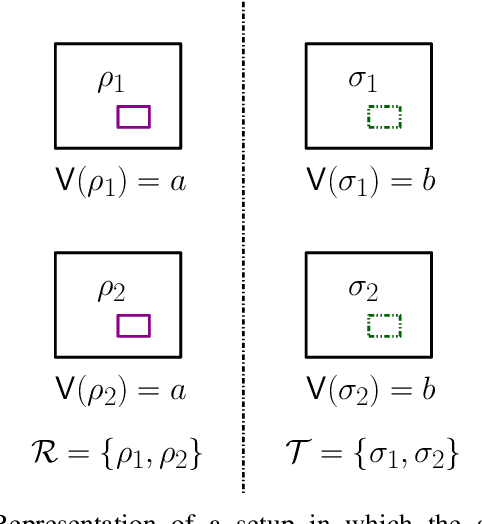
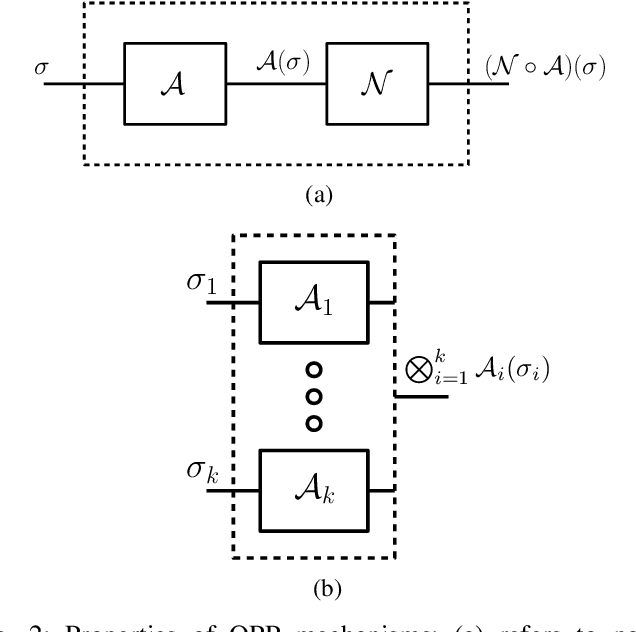
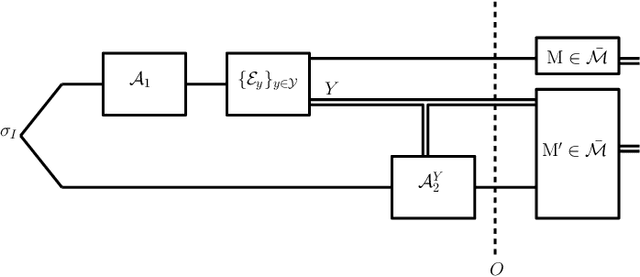
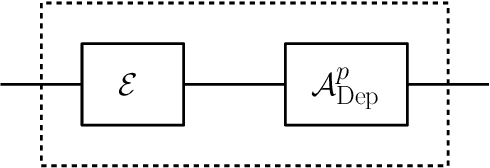
Abstract:We propose a versatile privacy framework for quantum systems, termed quantum pufferfish privacy (QPP). Inspired by classical pufferfish privacy, our formulation generalizes and addresses limitations of quantum differential privacy by offering flexibility in specifying private information, feasible measurements, and domain knowledge. We show that QPP can be equivalently formulated in terms of the Datta-Leditzky information spectrum divergence, thus providing the first operational interpretation thereof. We reformulate this divergence as a semi-definite program and derive several properties of it, which are then used to prove convexity, composability, and post-processing of QPP mechanisms. Parameters that guarantee QPP of the depolarization mechanism are also derived. We analyze the privacy-utility tradeoff of general QPP mechanisms and, again, study the depolarization mechanism as an explicit instance. The QPP framework is then applied to privacy auditing for identifying privacy violations via a hypothesis testing pipeline that leverages quantum algorithms. Connections to quantum fairness and other quantum divergences are also explored and several variants of QPP are examined.
k-Sliced Mutual Information: A Quantitative Study of Scalability with Dimension
Jun 17, 2022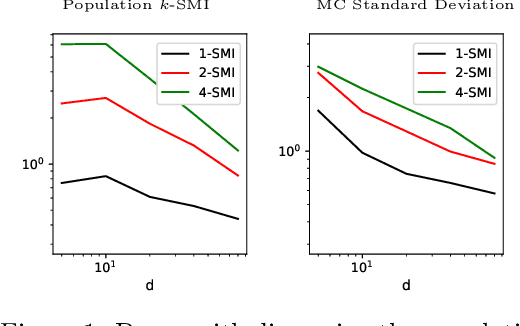

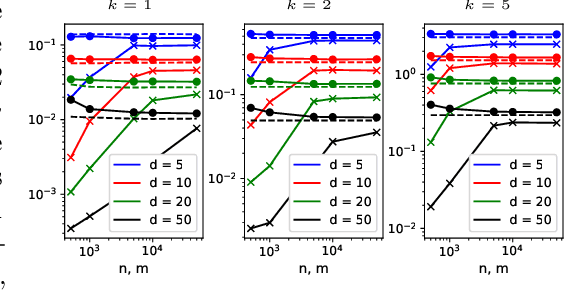
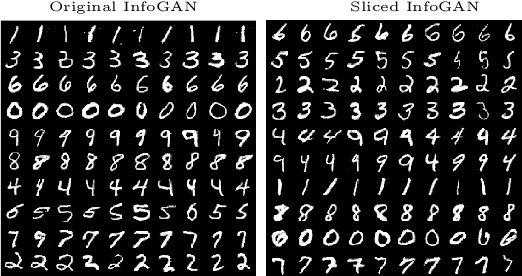
Abstract:Sliced mutual information (SMI) is defined as an average of mutual information (MI) terms between one-dimensional random projections of the random variables. It serves as a surrogate measure of dependence to classic MI that preserves many of its properties but is more scalable to high dimensions. However, a quantitative characterization of how SMI itself and estimation rates thereof depend on the ambient dimension, which is crucial to the understanding of scalability, remain obscure. This works extends the original SMI definition to $k$-SMI, which considers projections to $k$-dimensional subspaces, and provides a multifaceted account on its dependence on dimension. Using a new result on the continuity of differential entropy in the 2-Wasserstein metric, we derive sharp bounds on the error of Monte Carlo (MC)-based estimates of $k$-SMI, with explicit dependence on $k$ and the ambient dimension, revealing their interplay with the number of samples. We then combine the MC integrator with the neural estimation framework to provide an end-to-end $k$-SMI estimator, for which optimal convergence rates are established. We also explore asymptotics of the population $k$-SMI as dimension grows, providing Gaussian approximation results with a residual that decays under appropriate moment bounds. Our theory is validated with numerical experiments and is applied to sliced InfoGAN, which altogether provide a comprehensive quantitative account of the scalability question of $k$-SMI, including SMI as a special case when $k=1$.
 Add to Chrome
Add to Chrome Add to Firefox
Add to Firefox Add to Edge
Add to Edge